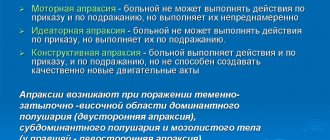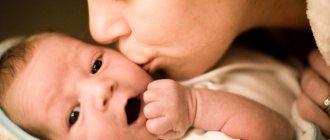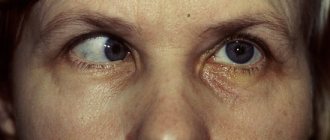Symptoms of epilepsy are a combination of neurological factors, as well as somatic and other signs, which indicate the occurrence of a pathological process in the neurons of the human brain. Epilepsy is characterized by chronic excessive electrical activity of brain neurons, which is expressed by periodic seizures. In the modern world, about 50 million people (1% of the world's population) suffer from epilepsy. Many people believe that with epilepsy a person must fall to the floor, convulse, and foam must flow from his mouth. This is a common misconception, imposed more by television than by reality. Epilepsy has many different manifestations that are worth knowing about in order to be able to help a person during an attack.
Precursors of seizures
Content:
- Precursors of seizures
- What do seizures look like in epilepsy?
- Symptoms of epilepsy in children
- Symptoms of nocturnal epilepsy
- Alcoholic epilepsy
- Nonconvulsive manifestations
- Duration and frequency of seizures
- Behavior of patients with epilepsy
Aura (from the Greek - “blow”) is a harbinger of an epileptic attack and precedes loss of consciousness, but not in any form of the disease. The aura can manifest itself with various symptoms - the patient may begin to sharply and frequently contract the muscles of the limbs and face, he may begin to repeat the same gestures and movements - running, flapping his arms. Various paresthesias can also act as an aura. The patient may feel numbness in various parts of the body, a crawling sensation on the skin, and some areas of the skin may burn. There are also auditory, visual, gustatory or olfactory paresthesias. Mental precursors can manifest themselves in the form of hallucinations, delusions, which are sometimes called preconvulsive insanity, a sharp change in mood towards anger, depression, or, conversely, bliss.
In a particular patient, the aura is always constant, that is, it manifests itself in the same way. This is a short-term state, lasting a few seconds (rarely more), while the patient is always conscious. An aura occurs when an epileptogenic focus in the brain is irritated. It is the aura that can indicate the dislocation of the disease process in the symptomatic type of epilepsy and the epileptic focus in the genuine type of the disease.
Forecast
The prognosis depends on the type of disease. Idiopathic epilepsy is characterized by a benign course, maintaining the usual level of mental activity and cognitive abilities. Sometimes it disappears spontaneously after puberty. In the symptomatic form, the outcome is determined by the underlying disease.
In the absence of serious cerebral changes, adequate selection of drug therapy makes it possible to completely eliminate attacks or significantly reduce their frequency. Significant improvement after surgery is observed in 60-70% of patients, complete recovery in 30%.
At the Leto clinic you can get qualified help for partial forms of epilepsy. High-quality diagnostics and competent medicinal support will allow you to solve the problem and return to a full life. Sign up by phone..
What do seizures look like in epilepsy?
Seizures due to changes in certain parts of the brain
Local, partial or focal seizures are the result of pathological processes in one part of the human brain. Partial seizures can be of two types - simple and complex.
Simple partial seizures
With simple partial seizures, patients do not lose consciousness, but the symptoms present will always depend on which part of the brain is affected and what exactly it controls in the body.
Simple seizures last about 2 minutes. Their symptoms are usually expressed in:
- a sudden causeless change in a person’s emotions;
- the occurrence of twitching in various parts of the body - limbs, for example;
- feeling of deja vu;
- difficulty understanding speech or pronouncing words;
- sensory, visual, auditory hallucinations (flashing lights before the eyes, tingling in the limbs, etc.);
- unpleasant sensations - nausea, goose bumps, changes in heart rate.
Complex partial seizures
With complex partial seizures, similar to simple ones, the symptoms will depend on the area of the brain that is affected. Complex seizures affect a larger part of the brain than simple ones, causing changes in consciousness and sometimes loss of consciousness. The duration of a complex attack is 1-2 minutes.
Among the signs of complex partial seizures, doctors identify:
- the patient's gaze into emptiness;
- the presence of an aura or unusual sensations that occur immediately before a seizure;
- patient screams, repeating words, crying, laughing for no reason;
- senseless, frequently repeated behavior, automaticity in actions (walking in a circle, chewing movements without reference to food, etc.).
After the attack, the patient experiences disorientation. He does not remember the attack and does not understand what happened and when. A complex partial seizure can begin with a simple one, and then develop and sometimes turn into generalized convulsions.
Generalized seizures
Generalized seizures are a seizure that occurs when pathological changes occur in a patient in all parts of the brain. All generalized seizures are divided into 6 types - tonic, clonic, tonic-clonic, atonic, myoclonic and absence.
Tonic seizures
Tonic seizures got their name due to the special effect on human muscle tone. Such cramps provoke tension in muscle tissue. Most often this affects the muscles of the back and limbs. Typically, tonic spasms do not cause fainting. Such attacks occur during sleep and last no more than 20 seconds. However, if the patient is standing while they occur, he is more likely to fall.
Clonic seizures
Clonic seizures are quite rare compared to other types of generalized seizures, and they are characterized by rapid alternating relaxation and contraction of muscles. This process provokes rhythmic movement of the patient. Most often it occurs in the hands, neck, and face. It will not be possible to stop such a movement by holding the twitching part of the body.
Tonic-clonic seizures
Tonic-clonic seizures are known in medicine as grand mal - “big disease”. This is the most typical type of seizures that occur with epilepsy in the minds of many people. Their duration is usually 1-3 minutes. If a tonic-clonic attack lasts longer than 5 minutes, this should be a signal to urgently call an ambulance.
Tonic-clonic seizures have several phases. In the first, tonic phase, the patient loses consciousness and falls to the ground. This will be followed by a convulsive or clonic phase, since the attack will be accompanied by twitching, similar to the rhythm of clonic seizures. When tonic-clonic seizures occur, a number of actions or events may occur:
- the patient may experience increased salivation or foaming from the mouth;
- the patient may accidentally bite his tongue, which will lead to bleeding from the bite site;
- a person, without controlling himself during a period of convulsions, can get hurt or hit surrounding objects;
- patients may lose control over the excretory functions of the bladder and bowels;
- The patient may experience blue discoloration of the skin.
After the end of the tonic-clonic convulsion, the patient is weakened and does not remember what happened to him.
Atonic attacks
Atonic or astatic seizures, which involve brief loss of consciousness by the patient, get their name due to the loss of muscle tone and strength. Atonic attacks most often last up to 15 seconds.
When atonic seizures occur in patients in a sitting position, either falling or simply nodding the head may occur. If the body is tense in the event of a fall, it is worth talking about a tonic attack. At the end of the atonic seizure, the patient does not remember what happened. Patients prone to atonic attacks may be advised to wear a helmet, since such attacks contribute to head injury.
Myoclonic spasms
Myoclonic seizures are most often characterized by rapid jerking movements in some parts of the body, like small jumps inside the torso. Myoclonic seizures mainly affect the arms, legs, and upper body. Even those people who do not suffer from epilepsy may experience myoclonic spasms when falling asleep or waking up in the form of twitching or jerking. Hiccups are also classified as myoclonic spasms. Patients have myoclonic seizures affecting both sides of their body. The attacks last a few seconds and do not cause loss of consciousness.
The presence of myoclonic seizures may indicate several epileptic syndromes, for example, juvenile or progressive myoclonic epilepsy, Lennox-Gastaut syndrome.
The nature of absence seizures
Absence seizure or petit mal most often occurs in childhood and is a short-term loss of consciousness. The patient may stop, look into emptiness and not perceive the surrounding reality. In complex absence seizures, the child experiences some muscle movements, such as rapid blinking of the eyes, or chewing-like movements of the arms or jaw. Absences last up to 20 seconds in the presence of muscle cramps and up to 10 seconds in their absence.
With a short duration, absence seizures can occur repeatedly even within 1 day. They can be suspected if the child is sometimes able to switch off and does not respond to the treatment of people around him.
Symptoms of epilepsy in children
Epilepsy in childhood has its own symptoms, in comparison with epilepsy in adults. In a newborn baby, it often manifests itself as simple physical activity, which makes diagnosing the disease at this age difficult. Especially when you consider that not all patients suffer from seizures, especially children, which makes it difficult to suspect a pathological process for a long time.
To understand exactly what symptoms may indicate childhood epilepsy, it is important to carefully monitor the child’s condition and behavior. Thus, children's nightmares, accompanied by frequent hysterics and screams, may indicate this disease. Children with epilepsy may sleepwalk and not respond when spoken to. Children with this disease may experience frequent and severe headaches with nausea and vomiting. The child may also experience short-term speech disorders, which are expressed in the fact that, without losing consciousness and motor activity, the child simply cannot say a word at some point.
All of the above symptoms are very difficult to detect. It is even more difficult to identify its relationship with epilepsy, since all this can occur in children without significant pathologies. However, if such symptoms occur too frequently, it is necessary to show the child to a neurologist. He will make a diagnosis based on electroencephalography of the brain and computer or magnetic resonance imaging.
Treatment
Neurologists at the Yusupov Hospital provide complex treatment for epilepsy. It is aimed at reducing the frequency of epileptic seizures and stopping medications during remission. According to statistics, in 70% of cases, adequately selected treatment helps to almost completely relieve paroxysmal activity in patients.
To achieve optimal results in treatment, patients are prescribed drugs for epilepsy of the following properties:
- anticonvulsants – help relax muscles, they are prescribed to both adults and children;
- tranquilizers - allow you to remove or reduce the excitability of nerve fibers; the drugs have shown a high degree of effectiveness in the fight against minor attacks;
- sedatives – help relieve nervous tension and prevent the development of severe depressive disorders;
- injections - used for twilight states and affective disorders.
Idiopathic focal epilepsy is benign. It requires symptomatic treatment. In focal forms with seizures that appear in series 2-3 times a month and are accompanied by an increase in mental disorders, neurosurgeons perform surgery.
Symptoms of nocturnal epilepsy
Epileptic seizures during sleep occur in 30% of patients with this type of pathology. In this case, seizures are most likely the day before, during sleep or just before waking up.
Sleep has fast and slow phases, during which the brain has its own peculiarities of functioning.
During the slow phase of sleep, the electroencephalogram records an increase in the excitability of nerve cells, the index of epilepsy activity, and the likelihood of an attack. During the fast phase of sleep, the synchronization of bioelectrical activity is disrupted, which leads to the suppression of the spread of electrical discharges to neighboring parts of the brain. This generally reduces the likelihood of an attack occurring.
When the fast phase is shortened, the threshold for seizure activity decreases. Sleep deprivation, on the contrary, increases the likelihood of frequent seizures. If a person does not get enough sleep, he becomes drowsy. This condition is very similar to slow sleep phase, which causes abnormal electrical activity in the brain.
Seizures are also triggered by other sleep problems, for example, even a single sleepless night can cause someone to develop epilepsy. Most often, if there is a predisposition to the disease, development is influenced by a certain period during which the patient had a clear lack of normal sleep. Also, in some patients, the severity of attacks may increase due to disturbances in sleep patterns, too sudden awakenings, from taking sedatives or overeating.
The symptoms of nocturnal epilepsy attacks, regardless of the patient’s age, can be varied. Most often, nocturnal seizures are characterized by convulsions, tonic, clonic seizures, hypermotor actions, and repetitive movements. With frontal autosomal nocturnal epilepsy, during attacks the patient may walk in his sleep, talk without waking up, and experience fear.
All of the above symptoms can appear in all sorts of combinations in different patients, so there may be some confusion when making a diagnosis. Sleep disturbances are typical manifestations of various pathologies of the central nervous system, not just epilepsy.
Diagnostics
Diagnosis of the disease occurs by taking an anamnesis. The specialist listens to complaints, on the basis of which a preliminary diagnosis can be made.
After this, the patient is sent for laboratory and hardware examinations, which makes it possible to differentiate epileptic seizures from other pathologies, allows one to find out the cause, the nature of the changes, determine the form and prescribe treatment.
The diagnosis is made by neurologists and epileptologists who determine the causes of epilepsy in adults using indications obtained from a comprehensive comprehensive examination.
Instrumental diagnostic methods
The safest hardware diagnostics is an EEG. It has no contraindications; it can be used to detect areas of paroxysmal activity. These can be sharp waves, spikes, slow waves. Modern EEG makes it possible to identify the exact localization of the pathological focus.
The most informative neuroimaging method is brain MRI. The study allows us to identify the initial cause of the deviation and determine the location of the lesion in the central nervous system.
Laboratory diagnostic methods
Epilepsy occurs under the influence of various reasons; in order to identify the presence of infection, inflammation, hormonal imbalances, genetic defects, the patient needs to take a general blood test, biochemical, molecular genetic, and check the tumor marker.
Alcoholic epilepsy
Alcoholic epilepsy occurs in 2-5% of chronic alcoholics. This pathology is characterized by severe personality disorders. It occurs in adult patients who have suffered from alcoholism for more than 5 years.
The symptoms of the alcoholic form of the disease are very diverse. Initially, the patient experiences signs of an approaching attack. This happens several hours or even days before it starts. Precursors in this case can last a different amount of time, depending on the individual characteristics of the organism. However, if warning signs are detected in a timely manner, an attack can be prevented.
So, with the harbingers of an alcoholic epileptic seizure, as a rule, the following occur:
- insomnia, loss of appetite;
- headache, nausea;
- weakness, weakness, melancholy;
- soreness in various parts of the body.
Such warning signs are not the aura that represents the onset of an epileptic seizure.
The aura cannot be stopped, nor can the seizure that follows it. But the warning signs, detected in a timely manner, can be treated, thereby preventing the occurrence of attacks.
First aid
A patient with epilepsy should be turned on his side. Do not put any foreign objects into the patient's mouth. A common misconception is that the patient's tongue can block the airway. This is not so: during an attack, all muscles come into motion, including the tongue, which is also a muscle. The tongue will not block the airway, but putting a spoon or other hard objects into the patient’s mouth can damage his teeth. If the patient has not regained consciousness 5 minutes after the onset of the seizure, it is necessary to urgently call an ambulance.
Epilepsy requires qualified treatment and constant medical supervision. The disease imposes some restrictions on life, for example, epileptics cannot drive or work in dangerous places. Nevertheless, with a favorable course and timely treatment, this disease allows you to lead a completely full life.
Nonconvulsive manifestations
About half of epileptic seizures begin with non-convulsive symptoms. After them, all kinds of motor disorders, generalized or local convulsions, and disorders of consciousness can be added.
Among the main non-convulsive manifestations of epilepsy are:
- all kinds of vegetative-visceral phenomena, irregular heart rhythm, belching, occasional increase in body temperature, nausea;
- nightmares with sleep disorders, talking in sleep, screaming, enuresis, somnambulism;
- increased sensitivity, worsening mood, fatigue and weakness, vulnerability and irritability;
- sudden awakenings with fear, sweating and palpitations;
- decreased ability to concentrate, decreased performance;
- hallucinations, delirium, loss of consciousness, pale skin, feeling of deja vu;
- motor and speech retardation (sometimes only in sleep), attacks of numbness, disturbance in the movement of the eyeball;
- dizziness, headaches, memory loss, amnesia, lethargy, tinnitus.
Duration and frequency of seizures
Most people believe that an epileptic attack looks like this: the patient’s cry, loss of consciousness and a person’s fall, muscle spasms, shaking, subsequent calming down and restful sleep. However, convulsions do not always affect the entire human body, just as the patient does not always lose consciousness during seizures.
A severe seizure may be evidence of generalized convulsive status epilepticus with tonic-clonic seizures lasting more than 10 minutes and a sequence of 2 or more seizures, between which the patient does not regain consciousness.
To increase the percentage of diagnosis of status epilepticus, time lasting more than 30 minutes, which was previously considered the norm for it, it was decided to reduce it to 10 minutes in order to avoid wasted time. With untreated generalized statuses lasting an hour or more, there is a high risk of irreversible damage to the patient’s brain and even death. At the same time, the heart rate and body temperature increase. Generalized status epilepticus can develop for several reasons at once, including traumatic brain injury, rapid withdrawal of anticonvulsant medications, and so on.
However, the vast majority of epileptic seizures resolve within 1-2 minutes. After the completion of a generalized attack, the patient may develop a postictal state with deep sleep, confusion, headache and muscle pain, lasting from a couple of minutes to several hours. Sometimes Todd's palsy occurs, which is a neurological deficit of a transient nature, expressed by weakness in the limb, which is opposite in location to the focus of electrical pathological activity.
Best materials of the month
- Coronaviruses: SARS-CoV-2 (COVID-19)
- Antibiotics for the prevention and treatment of COVID-19: how effective are they?
- The most common "office" diseases
- Does vodka kill coronavirus?
- How to stay alive on our roads?
In most patients, it is impossible to find any neurological disorders in the periods between attacks, even if the use of anticonvulsants actively inhibits the function of the central nervous system. Any decrease in mental functions is associated primarily with neurological pathology, which initially led to the occurrence of seizures, and not with the seizures themselves. Very rarely, there are cases of non-stop seizures, as is the case with status epilepticus.
Choice of treatment tactics
Based on the collected data, the doctor makes a decision on drug or surgical treatment of a certain type of disease. Let us remember that there is a pathology that cannot be treated with medications, so it is an indication for surgical intervention.
Often, to get a detailed understanding of the nature of the disease, doctors interview the patient’s relatives and ask them to describe the characteristics of the attacks; sometimes they ask them to make a home video in order to familiarize themselves with them. After analyzing all the obtained indicators, the doctor decides to conduct individual therapy using drugs that stop seizures.










